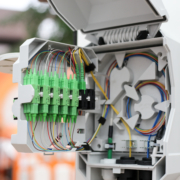What is PON? (Passive Optical Network)
What is PON? Passive Optical Network is a telecoms technology solution which uses fibre optic to deliver broadband network access to multiple users. PON is suited for both commercial and residential environments. Passive Optical Networks is the umbrella term for networking infrastructure that is based over fibre optic technology. This solution is considered to be the lowest cost, highest speed, and longest life solution in the industry.
What Is ODN (Optical Distribution Network)
PON solution has high flexibility and upgradeability options. This infrastructure has numerous optical network terminals which are connected from an Optical Line Terminal. Commonly, at the main communications room where the incoming IP Provider comes in. The terminals are connected through single-mode fibre (also known as Optical Distribution Network).
What is ONT? (Optical Network Terminal)
Optical Network Terminal or ONT is where the fibre element of the system is terminated as a demarcation point. The ONT will convert the fibre optical signals into electrical signals, this also works in the opposite direction. The Optical Network Terminal then terminates the fibre optic line within an inner compartment. In addition, it also terminates the property’s ethernet and phone wiring in an outer compartment.
What is OLT (Optical Line Terminal)
The Optical Line Terminal is centrally based. The system is processed through network cards and a gateway router. This serves the distributed ONT’s. This process uses optical splitters to spread the system. Furthermore, it can serve 128 ONT’s.
What is an Optical Splitter?
Optical Splitters serve as the central pathway creators within the PON system. Because the system does not require a power element apart from the original transmission and receiving ends, the splitters are used to diverge and route the signals through the distribution network. Optical splitters establish the route from the OLT to the various ONT’s.
Difference between Passive and Active Optical Networks
Passive Optical Networks systems ‘passive’ which means they only require power elements at the source and end points of the system. The routing and splitting of the networking is then done through fibre optic splitters in a passive manner.
An active system has individually powered switches or routers which are placed at interval points then take the signal and distributes it further along the network. Furthermore, there are various additional stages of powered equipment in the active system in comparison to a passive system.
What is GPON?
GPON is a passive optical network system that has the ability to carry Gigabit bandwidth throughout the system. This results in a high bandwidth and the reduction of bottlenecks which are generally seen in copper cable backbone systems. GPON and PON has much longer distribution reach, this is dependent on the manufacturer. Lastly, GPON can support multiple carrier services such as voice, data, and video. Which means its an all services solution in a single design.
What is PON Installation?
The network topology is structured around single-mode fibre optic cabling installation. Additionally, the design is then built around the specifications of that building and its future use and scalability.
Home installation
An internet provider will install a fibre optic cable which will be terminated into a demarcation box. This will be within the house and then into a fibre which goes to the home management box. Lastly, this will terminate into an optical network terminal (ONT), from here, copper structured cabling distributes throughout the house.
Office Installation
An internet provider will install a fibre optic cable which is then terminated into a main optical splitter for the building. A fibre optic cable will then feed from the splitter to each office space and into a fibre termination box. Much alike a home installation, this will then terminate into an ONT from where copper structured cabling distributes throughout the office.
Advantages of Passive Optical Network
- High Bandwidth
- Scalability and distance
- Reduced equipment and electronic powered equipment
- Energy Reductions
- Cost saving
- Future proof





